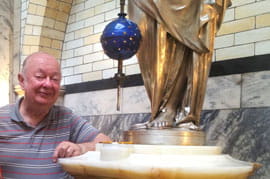Preserving a Piece of Drexel’s History

For the first time since it arrived at Drexel in 1912, the Eugene Farcot Conical Clock, along with its accompanying statue, has undergone full restoration.
The Farcot Conical Clock dates back to 1867, when George William Childs purchased it for his drawing room at 2128 Walnut Street. Eighteen years after Childs’ death in 1894, his wife donated the clock to the University in his memory.
Childs, a close friend and business partner of Anthony J. Drexel and a University trustee for more than 40 years, purchased the clock at the Parisian Exposition for a staggering $6,000, making it at the time one of the world’s most expensive clocks.
Drexel’s conical clock, which was previously valued at approximately $250,000 in non-working condition, is valued now in its restored condition at nearly $1 million.
The clock was designed and produced by French artisan Eugene Farcot, who was arguably the most well-known conical clockmaker of the 19th century. Conical clocks—built with a pendulum that moves in a circle rather than a typical back-and-forth motion—were surprisingly accurate, and these scarce timepieces are now highly sought after by collectors who value their advanced engineering as well as their aesthetic beauty.
[iframe width="560" height="315" src="http://www.youtube.com/embed/dN4AzhDEWCY" frameborder="0" allowfullscreen]
The silver statue that accompanies the clock was created by renowned French sculptor Albert Ernest Carriere-Belleuse.
Metals conservator Ed Cooper restored the sculpture and clock conservator and Drexel engineering alumnus Ronald Hoppes, ’60, restored the clock.
“I remember looking at that clock when I was a student in the 1950s and it always fascinated me,” Hoppes said. “It didn’t have the pendulum when I was a student and now it does. It’s finally complete after all these years.”
Hoppes wrote a book in 2009 about another of The Drexel’s Collection’s treasures, the David Rittenhouse Astronomical Musical Clock, which is housed in the Anthony J. Drexel Picture Gallery.
The Farcot Conical Clock housed in the Great Court is believed to be one of only three in the United States: one is located at the Clock and Watch Museum in Columbia, Pa., and another at the Roosevelt New Orleans, a Waldorf Astoria hotel.
In This Article
Drexel News is produced by
University Marketing and Communications.
